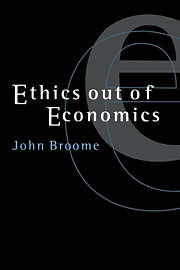Book contents
- Frontmatter
- Contents
- Preface
- 1 Introduction: ethics out of economics
- Part I Preference and value
- Part II The structure of good
- 6 Bolker–Jeffrey expected utility theory and axiomatic utilitarianism
- 7 Fairness
- 8 Is incommensurability vagueness?
- 9 Incommensurable values
- 10 Goodness is reducible to betterness: the evil of death is the value of life
- Part III The value of life
- Notes
- Bibliography
- Index
6 - Bolker–Jeffrey expected utility theory and axiomatic utilitarianism
Published online by Cambridge University Press: 12 November 2009
- Frontmatter
- Contents
- Preface
- 1 Introduction: ethics out of economics
- Part I Preference and value
- Part II The structure of good
- 6 Bolker–Jeffrey expected utility theory and axiomatic utilitarianism
- 7 Fairness
- 8 Is incommensurability vagueness?
- 9 Incommensurable values
- 10 Goodness is reducible to betterness: the evil of death is the value of life
- Part III The value of life
- Notes
- Bibliography
- Index
Summary
Introduction
In 1955, John Harsanyi proved a remarkable theorem. Assume everybody has preferences that conform to expected utility theory. Assume there are social preferences that also conform to expected utility theory. Finally, assume the social preferences satisfy the Pareto criterion. Harsanyi proved that, given these three assumptions, social preferences can be represented (in the manner of expected utility theory) by a utility function that is the sum of utility functions representing the preferences of the individuals. I call this the ‘Utilitarian Theorem’. Section 6.2 of this paper describes it in more detail.
The significance of the Utilitarian Theorem has been much debated. Harsanyi believes it supports utilitarianism. That is, perhaps, an overstatement, but I do think it throws enough light on the foundations of utilitarianism to justify the name I give it. It certainly makes a remarkable link between attitudes to risk and attitudes to inequality, which was Harsanyi's original purpose. But this paper is not about the theorem's significance; I have expressed my own views on that in my Weighing Goods. It is about its truth.
A number of proofs have been published besides Harsanyi's. Each is tied to a particular version of expected utility theory, and several rely implicitly on strong assumptions. Harsanyi's own proof assumes that probabilities are objective and known to everyone. Other existing proofs allow for subjective probabilities, but they all assume versions of expected utility theory that derive ultimately from Leonard Savage's. This paper tries out the theorem in the Bolker–Jeffrey version, which is radically different from Savage's. I shall argue in section 6.3 that there are good reasons to test the theorem inthis version. This paper proves the theorem within it. But it also shows the need for stringent assumptions.
- Type
- Chapter
- Information
- Ethics out of Economics , pp. 91 - 110Publisher: Cambridge University PressPrint publication year: 1999



